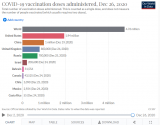View ORCID ProfileRoopa Kalyanaraman Marcello, Johanna Dolle, Areeba Tariq, Sharanjit Kaur, Linda Wong, View ORCID ProfileJoan Curcio, View ORCID ProfileRosy Thachil, View ORCID ProfileStella S. Yi, Nadia Islam
doi:
Abstract
There is growing recognition of the burden of COVID-19 among Asian Americans, but data on outcomes among Asian ethnic subgroups remain extremely limited. We conducted a retrospective analysis of 85,328 patients tested for COVID-19 at New York City’s public hospital system between March 1 and May 31, 2020, to describe characteristics and COVID-19 outcomes of Asian ethnic subgroups compared to Asians overall and other racial/ethnic groups. South Asians had the highest rates of positivity and hospitalization among Asians, second only to Hispanics for positivity and Blacks for hospitalization. Chinese patients had the highest mortality rate of all groups and were nearly 1.5 times more likely to die than Whites. The high burden of COVID-19 among South Asian and Chinese Americans underscores the urgent needs for improved data collection and reporting as well as public health program and policy efforts to mitigate the disparate impact of COVID-19 among these communities.
New York City (NYC) was the first region in the United States (U.S.) to experience a significant burden of COVID-19, with more than 200,000 cases, 50,000 hospitalizations, and 17,000 deaths between March 1 and May 31, 2020.1 NYC Health + Hospitals (NYC H+H), the city’s public hospital system and the largest in the nation, was hit hardest in the city and the nation during this time, with many of its 11 hospitals having neared capacity and additional temporary facilities having opened to accommodate the thousands of patients with severe illness.
Evidence from NYC and the nation since that time, including from the Centers for Disease Control and Prevention (CDC), has shown that Blacks and Hispanics bear a substantially higher burden of COVID-19 than Whites, with Asian Americans reported as experiencing only a slightly higher burden than Whites.2,3,4,5,6 However, community leaders and experts in Asian American health in NYC – which is home to the largest overall Asian and South Asian populations in the nation – and across the country have voiced concerns about the lack of attention to the substantial burden of COVID-19 among Asian Americans, many of whom have similar clinical, social, and economic characteristics as other Americans of color.7,8,9,10 This is due in large part to two key factors: 1) an undercount of Asian Americans in health system records because of inadequate or inaccurate data collection and reporting of Asian Americans’ race and/or ethnicity (i.e., as “other,” “unknown,” or an incorrect race, e.g., American Indian/Native American race instead of Asian race and Indian ethnicity), and 2) aggregating all Asian ethnic groups into a single race category, thereby obscuring differences in characteristics and outcomes between these diverse groups.
A recent systematic review and meta-analysis of 50 studies from the U.S. and the United Kingdom (U.K.) found a higher risk of COVID-19 infection among Asians and Blacks are compared to Whites and a likely higher risk of intensive care unit admission and death only among Asians as compared to Whites.11 Several studies from the U.K., where there is a large Asian and especially South Asian population, have shown an increased burden of COVID-19 among certain Asian ethnic subgroups, mostly South Asian and Indo-Caribbean communities.12
Recent media reports in the U.S. have begun to illuminate the heretofore largely invisible burden of COVID-19 among Asian Americans, but data to this end are still lacking from health systems and health departments.13,14,15 A recent CDC analysis of excess deaths due to COVID-19 found a substantial burden among Asian Americans, with a 36.6% increase in deaths in 2020 as compared to the average from 2015-2019, far higher than the 11.9% increase among Whites and second only to the 53.6% increase among Hispanics.16 Still, the impact of COVID-19 among Asian Americans and distinct Asian ethnic subgroups has not yet been fully elucidated.
As such, this study has two key objectives. First, we sought to characterize COVID-19 clinical and demographic risk factors and outcomes among Asian Americans tested for COVID-19 at NYC’s public hospital system, which serves thousands of Asian Americans each year. Second, we sought to identify if differences exist in characteristics and outcomes between Asian ethnic subgroups and other racial groups.

